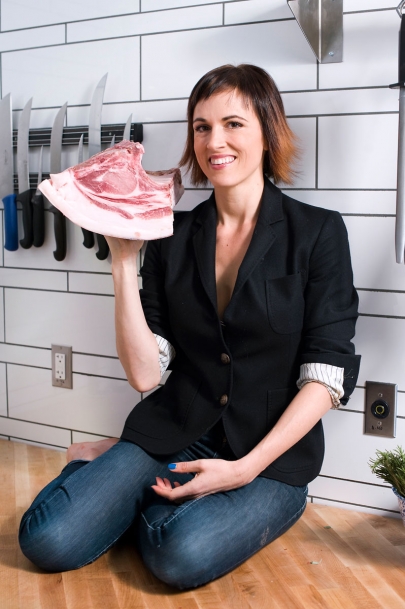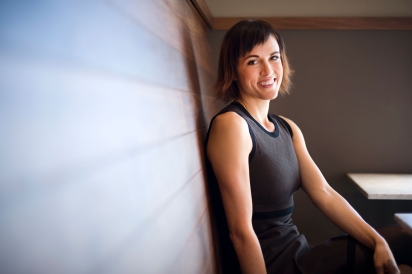The Meaty Ambitions of Anya Fernald
Romantics and dreamers are common in the local food arena, but it’s rare—and refreshing—to meet a romantic who can also crunch numbers. Anya Fernald, the CEO of Belcampo, Inc., is one of these, a person equally at ease waxing poetic about animal husbandry, scouring a balance sheet or searing the perfect steak. Her audacious vision is to produce good, healthy and environmentally responsible meat on a larger scale than ever before. With a farm, a processing plant and a growing network of restaurants and butcher shops in California, she’s doing just that, and she has every intention of making it pay.
Fernald spoke at the Aspen Food & Wine Classic in 2013, and edibleASPEN caught up with her before then to talk about the changing meat business and the challenges of making a living in uncharted agricultural territory.
edibleASPEN: What’s the message that you’re bringing to the Food and Wine Classic in Aspen this summer?
Anya Fernald: The broad goal for me is to talk about quality meat, eating less but eating better. Animal husbandry with grassfed and pasture-raised animals has the power to contribute to the health of the environment, and actually improve our world. At Belcampo we’re practicing ways of farming that can not only create the best tasting flavors, but also have the potential to sequester carbon and have a net positive environmental impact.
I think in America right now there’s an intense enthusiasm for consuming meat in a broad way, mixed with a real virulent anti-meat movement. On one side of the stadium, people are saying “bigger bigger burgers!” and on the other, it’s “no meat at all, let’s all be vegan!” I want to propose a middle road.
eA: You were a consultant for other food businesses for years. What made you want to dive in and launch your own venture?
AF: It was just the opportunity to do this on a bigger scale. I’ve done business planning for lots of small ventures, but this was the first time where there was financing to take it to a different level. Also, meat has always been attractive to me as an industry, just because there’s so much potential for change, and there’s a huge humane element to it. I really feel like conventional livestock farming in the U.S. is torture. The condition in which the animals are kept is abysmal. So to show a way in which we could do the right thing, be profitable and do it at scale was an extremely attractive proposition for me. I see so many farms, too, that are doing the right things, like raising beautiful chickens and treating the animals well. And there’s a lot of love, and a lot of poetry, and then they go bankrupt, even though they’re selling eggs for $12 a dozen!
eA: I think you may have coined the term “brokavore.” What does that mean?
AF: I see a lot of small-scale food businesses where there’s no profitability on their horizon. They get a lot of kudos, but if it’s not a viable business, it’s like a tree falls in the forest, you know? It’s cool to make things for your friends, but it’s not a product in the great tradition of artisan food. Artisan food makes money for farmers, and keeps rural life alive. I’m all for a thriving ecosystem of small food entrepreneurs, but I don’t want to see them out there not making money!
As a movement, we have to be insistent on people looking at scale, understanding how to get capital, and we have to give them the community support to say “You’ve got to do this big enough to make this into a life for yourself!” If that happens, then this movement will really mature.
eA: You founded the Food Craft Institute in Oakland to train young food entrepreneurs. Why?
AF: I spent a lot of time in Europe, where there’s a very codified way that you learn about craft food making—there’s apprenticeships, there’s schools. I think that’s limiting in some ways, because they don’t always have as many creative products as we do. But it’s also dignifying, because it legitimizes the whole business of being in food, it makes these into real professions and real jobs. So part of the mission was to re-dignify the food business.
The other piece of it was actually around the business side: a good 40 percent of our coursework is focused on business development, business management, reading profit-and-loss statements, that kind of stuff.
eA: In the Belcampo restaurant, diners can look through a dining room window and into a meat locker. Why did you feel that was important?
AF: I wanted people to be able to visually parse that we were working with whole animals. People who are smart about their meat are going to want to know where that meat comes from. So our statement is that we are a farm, we are a butcher, we are a shop, we own the entire chain of production. Having that meat locker right there sort of reinforces that, it’s like “Oh, yeah, they’re for real!”
eA: Your butcher shop and restaurant aim to acquaint people with nose-to-tail meat eating. How’s it going?
AF: We don’t require any great sacrifices or changes in people’s vision. I am not going to change the way America cooks, necessarily, and to be able to move hooves and shanks and stuff like that in a butcher case is extremely difficult. Also, the audience that knows how to cook those things is not always in the neighborhoods where Belcampo shops are going to thrive! We’re putting those hooves and shanks into our restaurant dishes; we’re not serving pickled pig’s ears straight up. Because of our scale at Belcampo, our pig’s ears go into dog treats, our hooves and bones go into broth. Getting people to love tongue or pig’s ears, that’s not my fight to fight. I like eating some of the more unusual cuts, but if I were offered a tongue sandwich or a steak sandwich, I’d take the steak sandwich! There’s a reason why we’ve gravitated toward the cuts that we have as a species.
eA: The idea of a humane slaughterhouse almost sounds like an oxymoron. Talk about what makes Belcampo’s different.
AF: A lot of times it has to do with the way the animals engage with the slaughterhouse from the outside. In slaughter plants you’ll often have animals showing up that have been on the road for five full days, and maybe sprayed with water once, and then they go straight to the kill floor. We really wanted to make sure that any animals that were processed came in that same day, so we didn’t put in corrals outside of our slaughterhouse. If you want to slaughter at our plant, you have to be fairly local, and you have to figure out how to get there on the day of processing. We’ve gotten some ranchers to change their practices in that regard. In the plant itself, the actual killing is pretty standardized, and it’s as humane as it can be. We process a maximum of 20 steer per day, so we take our time, and if there’s an animal that’s freaking out, they’re going to be calmed down. Just going slower: that’s the best thing in terms of animal handling.





